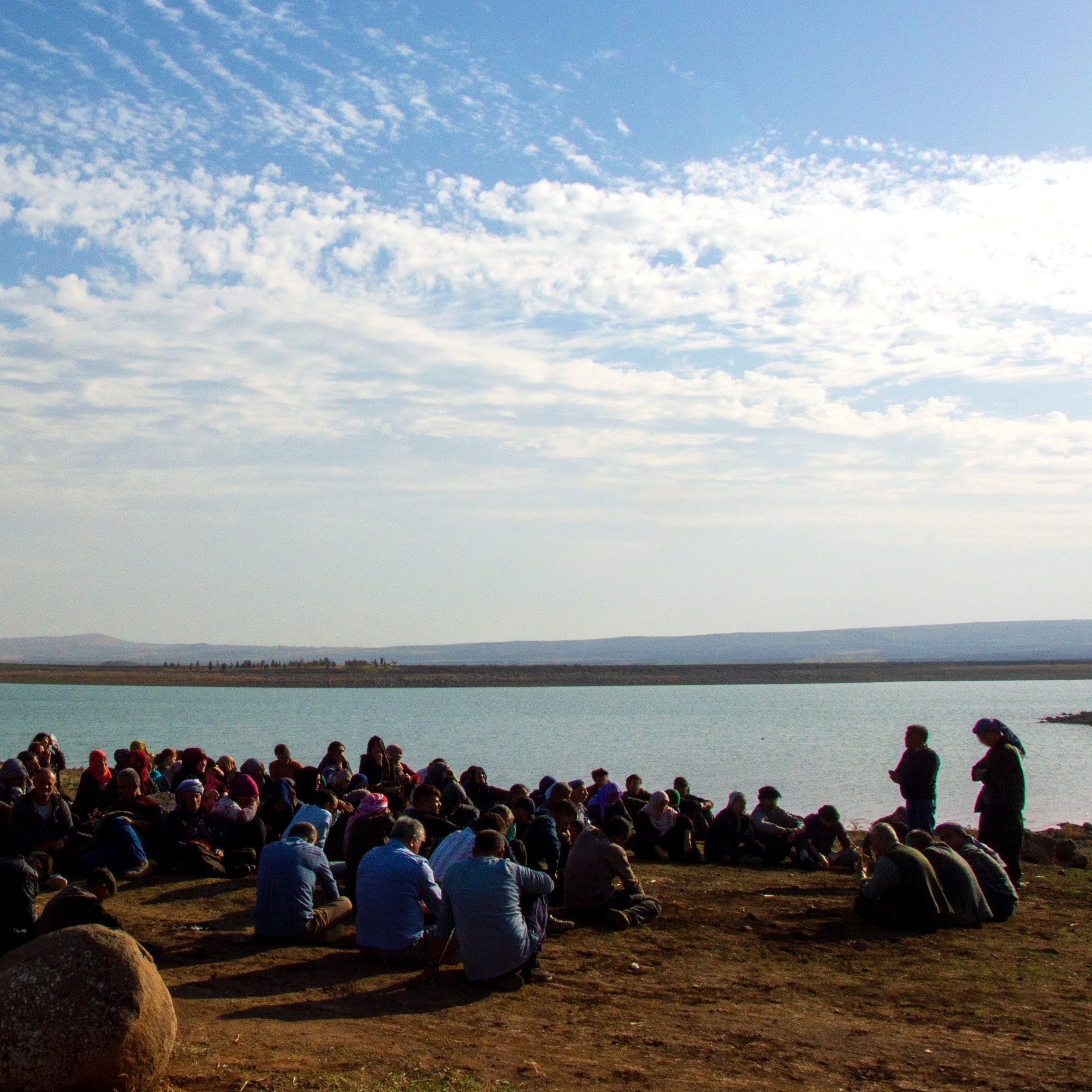BUILDING SOCIAL-ECOLOGY UNDER ATTACKS IN ROJAVA/NORTH-EAST SYRIA
Relatively unrecognized by the international public, the Turkish state has not only been killing civilians and political representatives in North-East Syria for years but also purposely carrying on an ecocide in the region, bombing basic civil infrastructure. Even in face of these attacks the population is resisting in order to defend their right to live on their land and the model/system of self-administration built up at the beginning of the revolution.
Rojava is one of the four parts in which Kurdistan has been divided with the creation of nation-states and the colonial division of the Middle East at the beginning of the 20th century. With this territorial division the Kurdish people too have been separated between Turkey, Iran, Iraq, and Syria. Rojava means “west” in Kurdish and refers to the western part of Kurdistan, the Syrian part.
The history of Kurdistan, the ecological way of life of the people, the effects of the attacks, and the methods of resistance are intrinsically related. In order to make them more understandable, we have focused on the area of Koçerata.
Koçerata and the people that are living here carry a heritage of hundreds of years of communal life, depending on and living in coexistence with the nature and the land, in a way that can fulfill the concept of social-ecological life.
Social ecology conceives the idea that a free, ecologic, and democratic life is possible only when the relation between society and ecosystems are harmonious and free from domination. The separation between the concepts of “subject” and “object” created the basis for all forms of oppression, patriarchy, and nature exploitation. Thinking of our society and communities as ecosystems allows us to understand that self-organization, connection with the land, co-existence of different identities, sustainable use of resources according to the needs and in balance with the environment, and self-defense are all aspects of a free life. While a large part of the population have been distanced from this reality by the capitalist mentality and life-style, in some regions like Koçerata, people are resisting in order to carry on this way of life.
From October 6th 2023 to January 15th 2024, the region and its people have been object to airstrikes carried out by the Turkish army. This rich and pioneering heritage is under massive attacks but still, people don’t even think about giving up their way of living or to leaving their land.
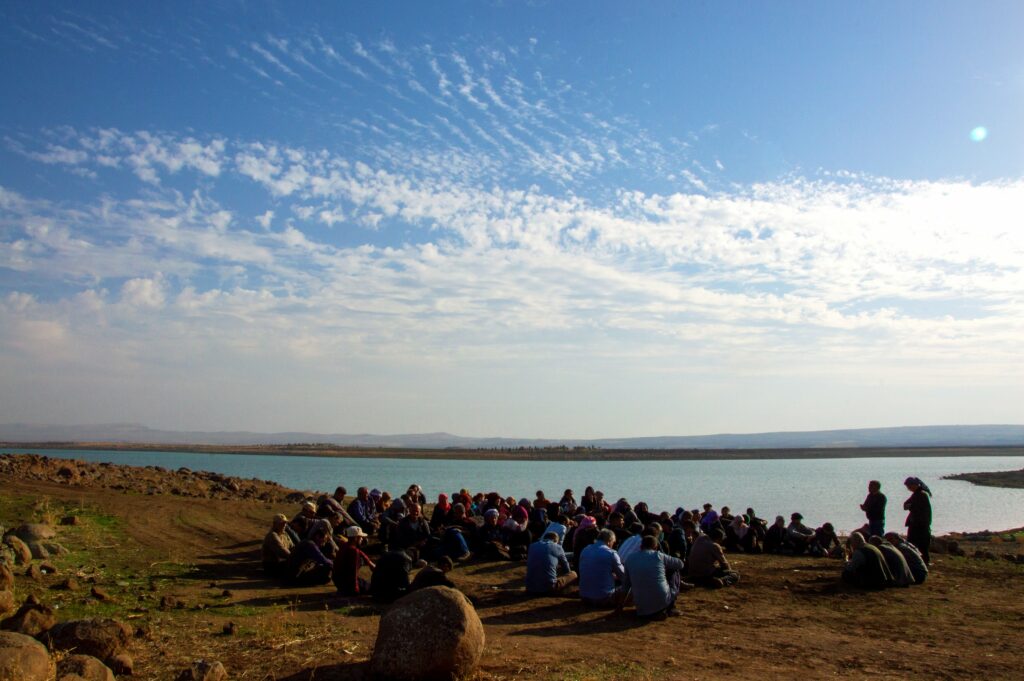
Meeting of an agriculture cooperative in Rubariya, near Dêrik. Source: self shot
Koçerata – the “land of the nomads”
The land between the heights of the Mountain Cudî in today’s Turkey, the mountain of Şengal in today’s Iraq, and the stream of the Tigris river is called Koçerata: the “land of the nomads.” If one stands on top of the mountain Qereçox and looks down from there, the whole plain in its beauty unfolds in front of one’s eyes.
This region was for hundreds of years home to nomadic and half-nomadic tribes, Kurdish as well as Arabic, living and working together. While the Arabic tribes were moving around in the plain, the Kurdish half-nomads (in Kurdish, Koçer) were staying in the plain for the winter and then moving with their herds, mostly sheep and goats, to the highlands in the North during the summer. The people lived like this until 1925, when nation-state borders were drawn in the Middle East. This deeply influenced the life of the half-nomads, cutting them away from the highlands. The Turkish state pursued a politics of homogenization and genocide, and the French occupation and the Syrian state also severely attacked the natural way of life of the people.
Not being willing to give up on their ancestors’ way of life too fast, many of the people continued to live in tents and moving in the plain until around 1945. Zehra Ali, an organizer in one of the two peoples’ councils of the region, still remembers this time: “Until I was 15, every weekend, when we would not have to go to school. We were going with buses and pickups to visit our parents who were staying with the herds. It was the most beautiful life, we were really sad when we had to go back to school.”
The Syrian state wanted to create a society living accordingly to the habits of modernism, rather than following their heritage. It imposed a monoculture economy on it, only allowing people who were loyal to the regime to work. The people were neither allowed to grow and harvest to sustain their own life. As in the rest of Rojava, in the region of Koçerata this forced more and more people to leave their villages for the bigger cities. There the people who lived independently from their own effort on their land had no other choice than to sell their labor force to the cheapest wage. Koçerata was also exploited for its rich oil deposits. One of the biggest power plants of North-East Syria was also based here, in Siwedî. Built in 1983 by a French company, it was one of the main gas and power station of whole North-East Syria, serving between 4 and 5 million people, until the winter attacks.
This economical colonization was also an attempt to destroy the hundreds of years of social-ecological life in the region, making the Kurdish identity completely forgotten and with this laying the foundation of exploitation of humans and nature in its whole. In the second part of the last century, a wave of industrialization and urbanism was imposed by the Syrian regime, and continued the process of undermining the half-nomadic life style, tearing the people away from their land.
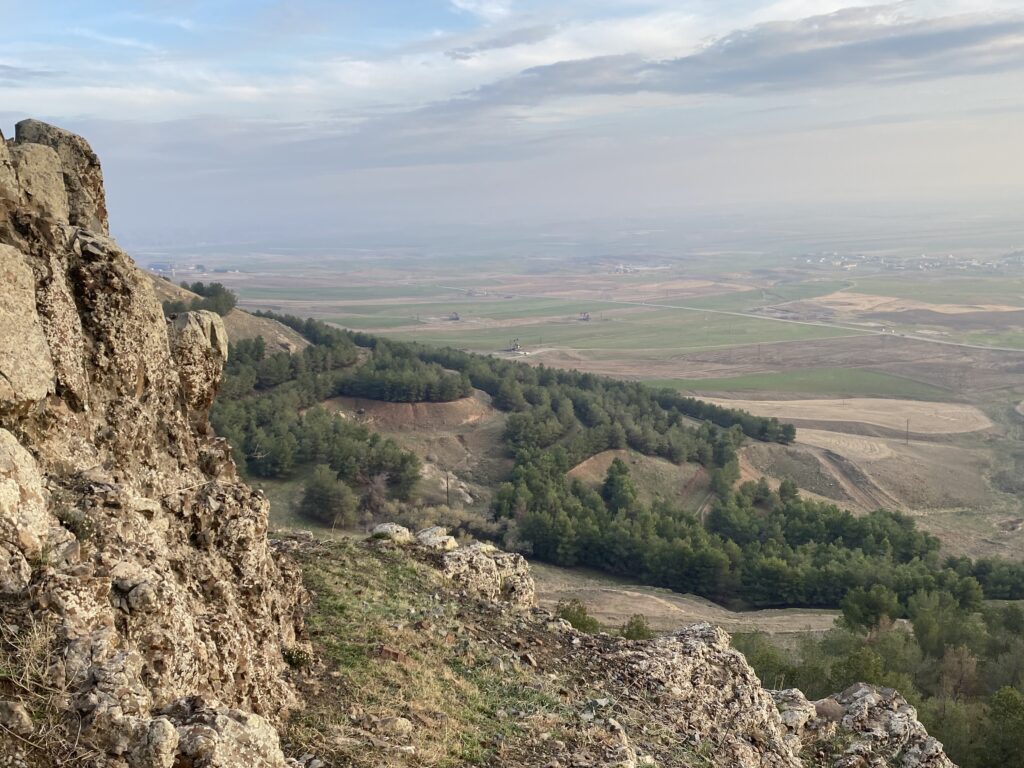
View on the Koçerata region from the mountain Qerecox. Source: self shot
The creation of a new life on the basis of old heritages
One of the pillars of the Rojava Revolution is ecology. On this basis the resistance against natural destruction to defend the ties between the people and their land is embraced. The people from Koçerata have been part of the liberation struggle in Kurdistan and of the revolution since the beginning. Lots of youth went to fight against ISIS and are now taking responsibilities within the self-administration structures.
After the Syrian state was expelled from the region and the autonomous administration was established, many families returned from the cities to build up their life in their own village again.
Rûken Şêxo, spokesperson of the people’s council in the village Girê Sor, describes the life of the people and the creation of social ecology in the region: “The life of the Koçer [kurd. half-nomads] is very simple and beautiful. We don’t need a lot from the outside. In every house you will find a small garden, where the families are growing vegetables, herbs, and plants, for example tomatoes, onion, salad. Some will also raise cows, chickens, and turkeys… We make things ourselves, especially yogurt, cheese, and milk. From our childhood onward we learned to create everything by ourselves, from the things we have. This is also what we are going to teach to our children.”
Turkey’s war against Rojava: An attack on the development of social ecology
The process of building up, organizing the society, and developing social ecology is happening under threat and attacks, now for thirteen years, with its main actor being the Turkish state and its attempts to break the autonomy of the people of North-East Syria.
Even though heavy attacks were executed in November 2022, targeting in particular the infrastructure for basic life needs (water and electricity), the most recent bombardments, from October 6th 2023 to January 15th 2024, mark the worst escalation since 2019. In this period the Turkish army carried on more than 650 strikes (with drones and fighter jets), hitting more than 250 places, many of them being hit several times. In this huge operation, 56 people have been killed (among them two children, 10-11 years old), while at least 75 people have been injured, including workers at their work site or collecting cotton in fields. The airstrikes have mainly targeted essential infrastructure: 18 water stations, 17 electricity plant, sites for cooking gas, and oil facilities, but also schools, hospitals, factories, industrial sites, agricultural and food production facilities, storage centers for oil, grain, and construction materials, medical facilities, and villages.
The main objects of this airstrike campaign have been electricity, gas, and water infrastructure.
The purpose is clearly to destroy the basis of people’s life. The war on infrastructure is a war on the people. Beside the physical destruction, these attacks aim to harm society’s psychological status and destabilize the region, in order to stop, with any means possible, the democratic process that is going on within the Autonomous Administration.
Koçerata became a central target due to important infrastructural sites placed in the region which are essential for the production of electricity, cooking gas, and petrol. Being mainly a rural and agriculture-based region, the relation between war and social ecology here appears very clearly.
The electrical situation was already drastically impacted, since Turkey started cutting more and more the water flow coming to Rojava after the beginning of the revolution. At the time, the rivers were the main source of electricity for the region. For this reason in the last years the Administration was forced to move back to the use of energy sources based on fossil fuels, in order to be able to ensure basic needs such as heat, cooking gas, and some hours of electricity.
One of the most critical infrastructural targets was the electricity plant of Siwedî. “Being the main gas and power station of whole North-East Syria, when there are problems within the plant, it affects the whole region,” we were told by Rûken Şexo, spokesperson of Girê Sor village. “After that shelling almost 4 to 5 million people have been affected,” and, in Cizîrê region, where 50% of the regular electricity comes from this plant, two million residents have been left without municipal services, electricity, power, and water. In January, Turkish army carried out such heavy airstrikes on the station that the plant has been almost completely destroyed. Now the percentage of the destroyed part reaches 90%. This situation makes impossible to even consider a normal process of repairing what has been bombed.
More Information: https://rojavainformationcenter.org/2024/01/turkish-airstrikes-on-suwaydiyah-power-station-documenting-the-damage/
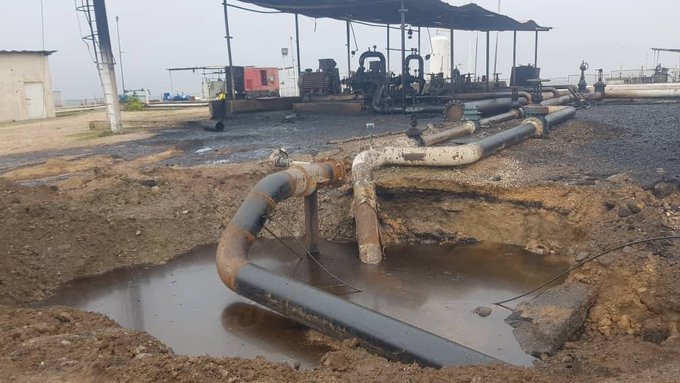
Destroyed petrol lines near Xaneserê, close to Dêrik. Source: self shot
Shellings on Koçerata
“The shellings are hurting the people of Koçerata, in all aspects of life,” Xoşnav Hesen from the village of Girê Kendal said to us. “These are from the attacks” he said, while showing us the deep cracks on the walls of his house. “Around our village many places were bombed. A barn was also targeted, killing 200 sheep. We have been many days without electricity and water.” The villages are mainly connected to the general electricity line, which leads, in case of lack of electricity, to heavy impacts on all aspects of life. One of these is access to water. Without electricity the water pumps can’t work, so water can’t be extracted from the wells and distributed to the villages. While this is in general a fundamental problem for human life, in the region it is even more crucial due to the agriculture-based life of the people. The water situation was generally already dire due to the cut of water taken by Turkey. What was once called the fertile crescent, crossed by Euphrates and Tigris, has experienced heavy droughts in recent years. The river flow that was allowed to cross into Rojava decreased severely, (42%, with peak-days of 80% of reduction), obviously affecting all aspects of life, drinking, hygiene and health, agriculture and food production, animal life, economy, education, and gender dynamics. In addition, the Turkish state has also altered the water quality, releasing contaminant sewage residues in the little water still flowing into North-East Syria.
“Most of the people live from the products of the earth and the animals that they raise themselves,” said Rûken Şexo, spokesperson of Girê Sor village. “Without water, the plants are dying and the animals can not drink. The cultures are affected, the animal’s life is affected. The base of people’s economy, of families’ economy in the region is based on this. Now the families are having economic problems, because they used a lot of money to plant and now everything is gone; the animals are dying because of lack of water.” These military operations aim to create fear and frustration. “Creating, building up, is not a problem: the problem is war. You work so much, create so much, invest so many resources, and then, in one second, it gets destroyed,” said Delal Şêxo from the village of Hamza Beg.
More information: https://makerojavagreenagain.org/ecocide-in-kurdistan-a-product-of-colonization/
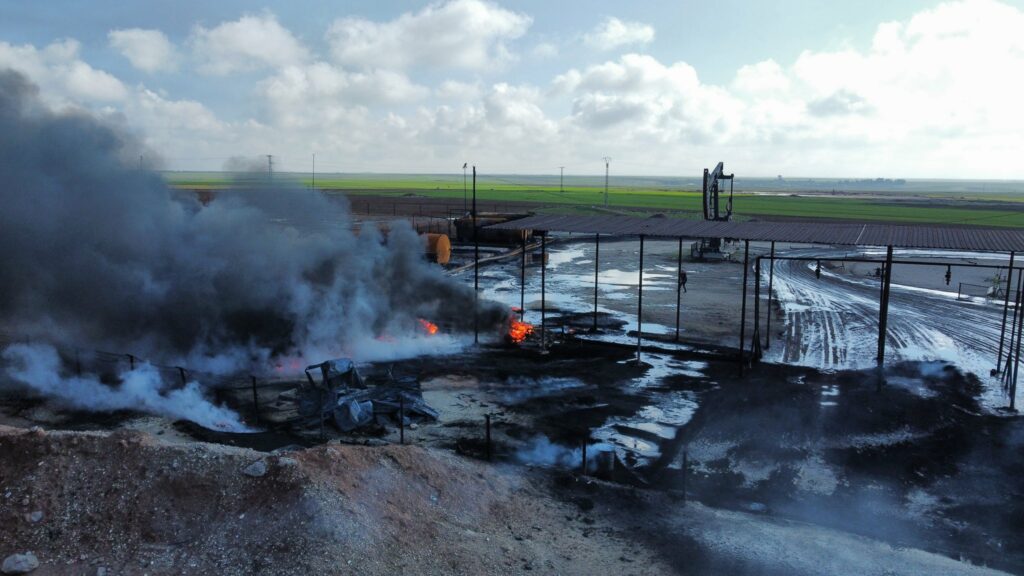
Destroyed tubes and petrol lines in Siwedî. Source: self shot
“We don’t leave our land, we organize ourselves” – Resistance of the people on their land
Ecological factors have been among the causes contributing to the onset of the war in Syria. Droughts and regime policies resulted in a massive exodus to urban centers, limited access to basic needs, and humanitarian crises, ultimately leading to the uprisings of 2011. During the subsequent war, numerous human and ecological crimes were committed, such as the use of chemical weapons by the regime and Turkey, or the scorched-earth strategy employed by ISIS in its retreats (i.e. poisoning water sources and destroying oil infrastructure and chemical factories). The current attacks led by the Turkish state must be understood in this broader context of war and ecology.
Besides the direct ecological consequences of the dams, destruction of oil infrastructure, and the tree cuttings, there are also indirect ecological consequences that involve hindering the progress of the Revolution. This systematic destruction of basic infrastructure forced the administration and the whole economy of North-East Syria to devote themselves toward continuous works of reparation and rebuilding, inuring in high costs, in terms of human and financial resources.
This warfare impedes the development of agro-ecology and eco-industry, which the Autonomous Administration views as priorities.
The paradigm of the Rojava Revolution aims to foster the development of a society based on grassroots democracy, women’s liberation, and social ecology. In this framework ecological sustainability, self-sufficiency, local production and consumption, and decentralization are crucial. However, the decentralization of certain infrastructures faces challenges not only due to the attacks but also due to the embargo. The construction of smaller, decentralized infrastructures—such as electricity production—is on the agenda, but some necessary materials are still unavailable and cannot be transported across borders. The unavailability of certain material adds further difficulties to the maintenance of existing structures and leads to increasing dependence on oil. Even in the case that building new infrastructure was begun, it would still face the threat of destruction. Essentially, this aggression attempts to eliminate the still-present experiences of social-ecological life and to obstruct the emergence of a social and ecological revolution in order to perpetuate the capitalist system—despite its inevitable collapse due to environmental factors. Institutions have to draw emergency plans during and after each wave of attacks, which compromises their capacity to work on long-term projects. Plans regarding the use of different source of energy (solar, biogas from animal manure and organic wastes, or wind energy), and the development of organic fertilizers could also not develop on a large scale because of these limiting conditions and the necessity to respond to emergencies and the immediate consequences of war. For ideological and practical resistance, the Revolution draws inspiration from the wisdom of natural society and adapts it to the current context. In spite of the aggression of capitalist modernity, decentralized and ecological economy finds examples in the sustainable aspects of the traditional way of life. In contexts of forced settlement, remapping of the region, and environmental changes imposed by hegemonic powers for centuries, people of Koçerata develop their solutions in line with their values and cultural heritage. Aligned with their will to keep their land, they conserved ecological and sustainable practices through their agriculture and shepherding as well as through the sharing of resources.
In the whole region of North-East Syria, direct and indirect attacks to countryside areas and agricultural fields compromise not only the activities related to food production but also the people’ attempts to recover the original quality of the soil, impoverished after years of imposed intense monoculture. The transition to sustainable and traditional methods of agriculture and agro-ecology is led not only by the will to recover techniques from the past; it fully reflects the principles of richness in diversity and resilience, in communities as well as in ecosystems.
Connection with the land and the re-establishment of a balanced relation with nature also constitutes a fertile framework for the development of democratic relations and structures. Staying on one’s land and organizing life communally is also a way to defend one’s identity and traditions and strengthen the culture of resistance. The attempts of the Turkish state to make people flee do not aim only to physically empty the land but also to interrupt the transmission of culture and knowledge, regarding agriculture—such as traditional methods, seasonal changes, and local plants—and any other field of life.
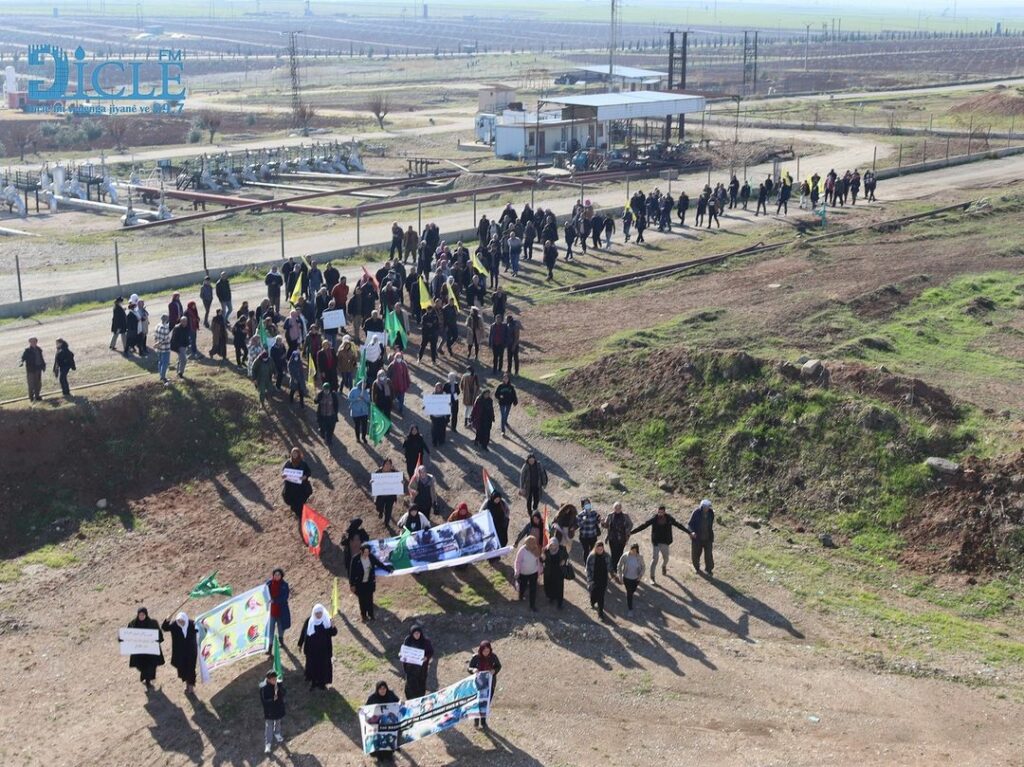
Human Shield Demonstration to the Gas-Power-Station in Girê Siro, near Dêrik. Source: https://www.instagram.com/diclefm/
The Autonomous Administration of North-East Syria encourages the establishment of cooperatives for agro-ecology, like the production of organic fertilizers, and eco-industries based on the cooperative system and on a circular approach to production and consumption. In a centralized economic system, numerous localities depend on a single infrastructure. Military attacks can therefore paralyze the society by targeting a few key areas. Decentralization, however, could reduce the effectiveness of this warfare. A single attack would affect just a part of the whole infrastructural network and the impact could be balanced by the operational continuity of other decentralized sites. Additionally, a decentralized system implies smaller and simpler infrastructures that can be more easily maintained. Furthermore, better self-sufficiency is the answer to withstand embargo policies. Such would ensure logistical support to both civilians and military structures for the continuation of social life and self-defense.
Local social and economical autonomy fosters the ability of people to organize their own forces. Despite difficulties and threats, the people are showing a strong solidarity among themselves and a determination to stay on their land, developing ways to collectively withstand the hardships. The municipality visits the different Communes to inform them, share evaluations about the situation, listen to their needs, try to find solution together, and to collectively organize the whole society, making everyone take responsibility for it. The people of Koçerata pool their resources in times of difficulty. Neighbors share generators and water pumps during electricity shortages. Some villages deliberately limit their electricity for hours to support others. Certain families combine financial resources to afford a communal water pump system independent from electricity. During the attacks of October 2023, the five hundred workers of Siwedî repaired and maintained the infrastructure to restore electricity to the people, despite the airstrikes and the fear of being targeted again. Various strategies have been devised to safeguard both people and their lands. During the airstrikes in late December, the Koçerata community mobilized to create human barriers around the Siwedî power plant. For several days, crowds congregated around the power plant, aiming to shield it from airstrikes. Later on, in January, even on the ruins of Siwedî the high spirit of the community couldn’t be defeated. Then came the time of new initiatives. In each village, residents began pooling funds to support the installation of local generators. The priority is to set up an emergency plan, yet for their long-term strategy towards social ecology, the force of solutions is already there: initiative from the base, self-organization, and decentralization.
The foundation of ecological resistance lies in the connection between people and the land. The land is home: it needs to be protected from aggression and must be taken care of in order to ensure the continuity of life. While many attempts have been made to alienate and displace the people in Koçerata, most of them have made the decision to stay on their lands. This determination to resist and build local autonomy forms the roots of both self-defense and ecological practices.
Resistance and autonomy go hand in hand with ecological consciousness. In this framework social-ecological models, self-sustainability, and decentralization can really constitute a solution for a lasting peace in the region. In this framework, the reality of Koçerata constitutes a meaningful and inspiring example, not just of theory but of practice, of resistance and self-organization. Against the current centralized, urbanized and mono-culture global system, based on exploiting relationships between humans and the land, Koçerata can suggest sustainable ways of living, working and producing.
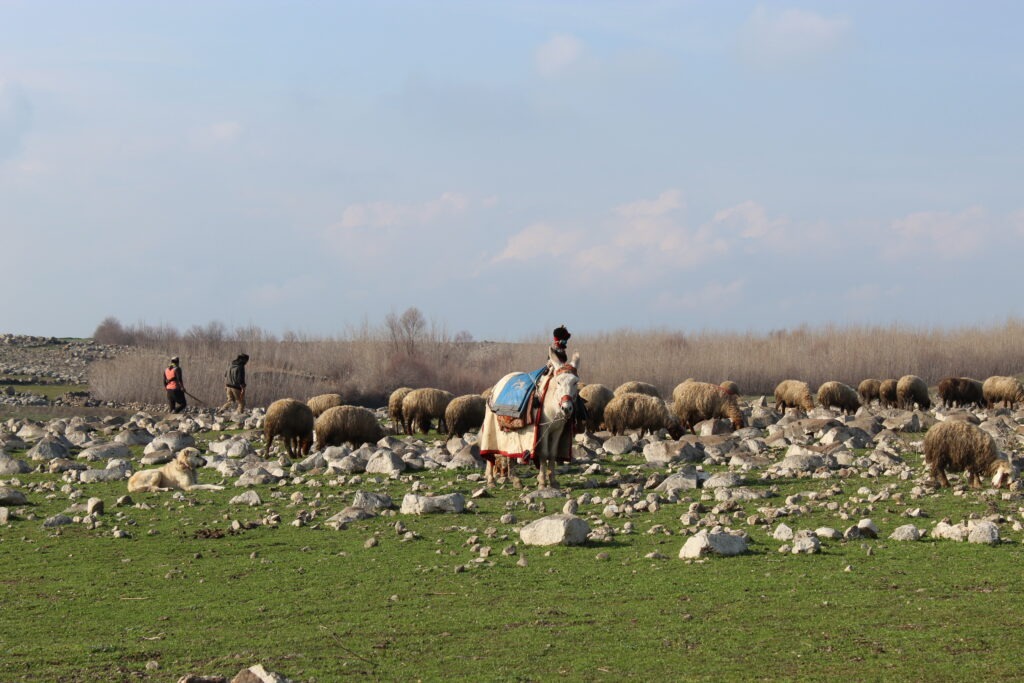
Shepherd with his sheep in Koçerata. Source: self shot.
More information: https://anfenglishmobile.com/rojava-syria/people-of-north-and-east-syrian-resolute-in-their-resistance-against-the-occupiers-71178
This blog post is an abridged and edited version of a longer report by Make Rojava Green Again. You can read the full report here.

